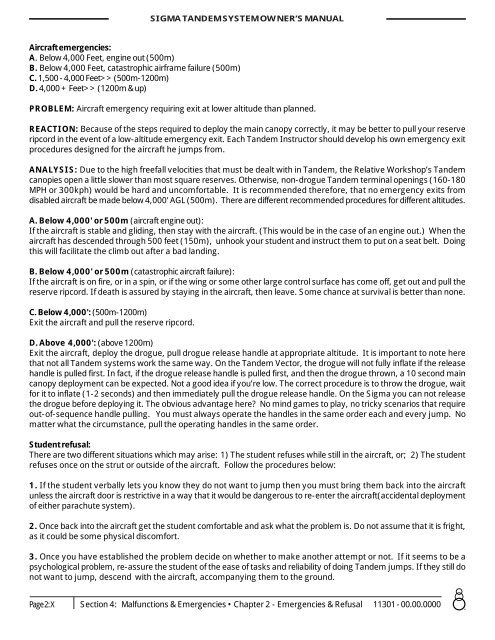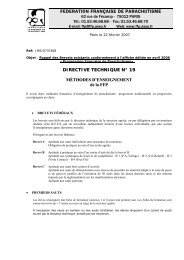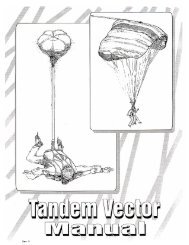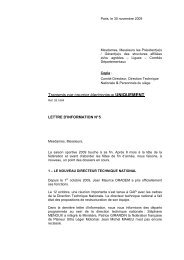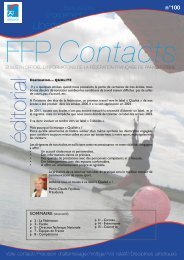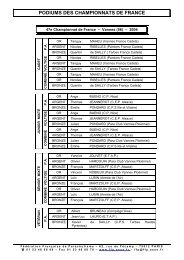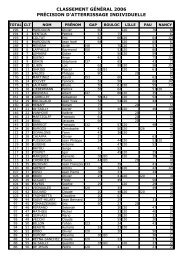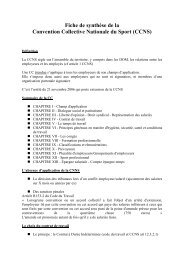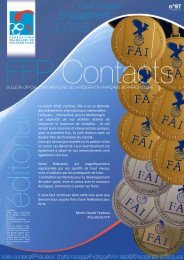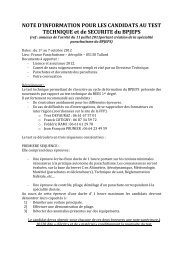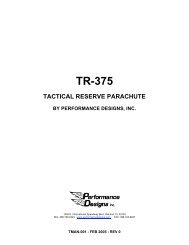tandem vector owner's manual
tandem vector owner's manual
tandem vector owner's manual
Create successful ePaper yourself
Turn your PDF publications into a flip-book with our unique Google optimized e-Paper software.
SIGMA TANDEM SYSTEM OWNER’S MANUAL<br />
Aircraft emergencies:<br />
A. Below 4,000 Feet, engine out (500m)<br />
B. Below 4,000 Feet, catastrophic airframe failure (500m)<br />
C. 1,500 - 4,000 Feet>> (500m-1200m)<br />
D. 4,000 + Feet>> (1200m & up)<br />
PROBLEM: Aircraft emergency requiring exit at lower altitude than planned.<br />
REACTION: Because of the steps required to deploy the main canopy correctly, it may be better to pull your reserve<br />
ripcord in the event of a low-altitude emergency exit. Each Tandem Instructor should develop his own emergency exit<br />
procedures designed for the aircraft he jumps from.<br />
ANALYSIS: Due to the high freefall velocities that must be dealt with in Tandem, the Relative Workshop’s Tandem<br />
canopies open a little slower than most square reserves. Otherwise, non-drogue Tandem terminal openings (160-180<br />
MPH or 300kph) would be hard and uncomfortable. It is recommended therefore, that no emergency exits from<br />
disabled aircraft be made below 4,000' AGL (500m). There are different recommended procedures for different altitudes.<br />
A. Below 4,000' or 500m (aircraft engine out):<br />
If the aircraft is stable and gliding, then stay with the aircraft. (This would be in the case of an engine out.) When the<br />
aircraft has descended through 500 feet (150m), unhook your student and instruct them to put on a seat belt. Doing<br />
this will facilitate the climb out after a bad landing.<br />
B. Below 4,000' or 500m (catastrophic aircraft failure):<br />
If the aircraft is on fire, or in a spin, or if the wing or some other large control surface has come off, get out and pull the<br />
reserve ripcord. If death is assured by staying in the aircraft, then leave. Some chance at survival is better than none.<br />
C. Below 4,000': (500m-1200m)<br />
Exit the aircraft and pull the reserve ripcord.<br />
D. Above 4,000': (above 1200m)<br />
Exit the aircraft, deploy the drogue, pull drogue release handle at appropriate altitude. It is important to note here<br />
that not all Tandem systems work the same way. On the Tandem Vector, the drogue will not fully inflate if the release<br />
handle is pulled first. In fact, if the drogue release handle is pulled first, and then the drogue thrown, a 10 second main<br />
canopy deployment can be expected. Not a good idea if you’re low. The correct procedure is to throw the drogue, wait<br />
for it to inflate (1-2 seconds) and then immediately pull the drogue release handle. On the Sigma you can not release<br />
the drogue before deploying it. The obvious advantage here? No mind games to play, no tricky scenarios that require<br />
out-of-sequence handle pulling. You must always operate the handles in the same order each and every jump. No<br />
matter what the circumstance, pull the operating handles in the same order.<br />
Student refusal:<br />
There are two different situations which may arise: 1) The student refuses while still in the aircraft, or; 2) The student<br />
refuses once on the strut or outside of the aircraft. Follow the procedures below:<br />
1. If the student verbally lets you know they do not want to jump then you must bring them back into the aircraft<br />
unless the aircraft door is restrictive in a way that it would be dangerous to re-enter the aircraft(accidental deployment<br />
of either parachute system).<br />
2. Once back into the aircraft get the student comfortable and ask what the problem is. Do not assume that it is fright,<br />
as it could be some physical discomfort.<br />
3. Once you have established the problem decide on whether to make another attempt or not. If it seems to be a<br />
psychological problem, re-assure the student of the ease of tasks and reliability of doing Tandem jumps. If they still do<br />
not want to jump, descend with the aircraft, accompanying them to the ground.<br />
Page 2:X Section 4: Malfunctions & Emergencies • Chapter 2 - Emergencies & Refusal 11301 - 00.00.0000


